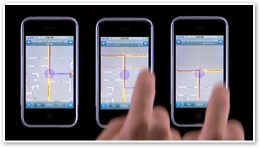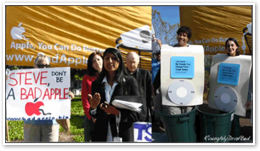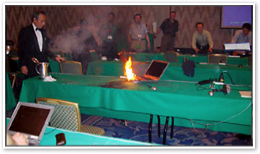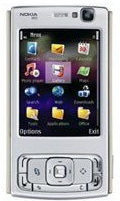


Last week, Slate Magazine nearly managed to earn John Gruber's Jackass of the Week award for an article by Jack Shafer lamenting the media attention on the iPhone.
Were it not for a photo-finish dash by hall of famer Rob Enderle, Shafer might have gone down in JotW history as one of the less interesting awardees of the Daring Fireball’s infamous prize. Instead, Shafer had to settle for an implied runner up jackass position, which seems to be more insulting than actually winning.
Shafer was particularly embittered that Apple announced a jump in battery life and YouTube support before the iPhone's launch. “No drop of milk oozes from the Apple teat without a crowd of journalists gathering to swallowing it up,” he complained.
Is Shafer speaking of himself? Is he pointing out that journalists feed off press releases like caged guinea pigs? Wow, thanks for the incisive look at your own business, Slate. What's up next, a look at why the jump in iPhone battery life Apple announced is really a conspiracy, a fraud, or some dark reality distortion?
Why Yes, How Did You Guess?
Following up on Shafer's wannabe jackassery, David Sessions grabbed the baton and made a dash at this weeks’ jackass award by publishing an exposé purporting to reveal how Apple must have faked its increased battery life.
In order to win the Jackass Cup, who better to train from than the “High Water-Mark of Jackassery,” Enderle himself? Salon’s Sessions began by Enderle-larly self reporting using a third person entity name:
“On Wednesday, Jack Shafer mocked journalists for lavishing attention on this tiny morsel of news.” Sessions began. “Even so, that clever bit of Apple PR got Explainer wondering: How do you make a battery last longer?”
How indeed: an improved battery? More efficient use of battery power? Oh wait, that's about the whole range of options available. You’re right, this is a morsel of non-news! Why are you building it into a story? Does that make you one of those mock-worthy journalists dashing in to cry over spilt milk?
What Teat Did That Squirt From?
Things get worse. In order to bridge the gap from intellectual critic’s magazine to tech-savvy journal, Slate had to bring in some outside experts. Who would one have to call to get secret information on the iPhone?
-
•How about Brian Lam of Gizmodo, who recently published an impassioned plea to boycott the iPhone?
-
•How about Rob Enderle, who calls the iPhone “damned” and “not a very good phone” at every chance?
Sure enough: Slate “thanks Richard Doherty of the Envisioneering Group, Rob Enderle of the Enderle Group, Ian Hill of the NRC Institute for Chemical Progress and Environmental Technology, and Brian Lam of Gizmodo” for helping put the article together.
It should also be noted that Slate was started by Microsoft and then sold to the Washington Post, which is today singularly the most anti-Apple paper in that nation. 

It even outranks Microsoft's own backyard Seattle Post-Intelligencer and Sausage Land's San Jose Mercury News, and that's saying a lot.
Even so, Apple features the Washington Post on its Pro site as being a huge Mac customer. Mac users must be the biggest bunch of complainers on the planet! Let’s complain about Slate’s silly article.
Slate Hits Rock Bottom.
Undermining the premise of its own article, Slate says “There are no surprise technologies that can make a standard battery retain its juice longer.” What a disappointment! I came to read about why the battery was going to last longer, not for the sad realization that Slate and its iPhone critics really don't really have anything to offer on the subject.
Slate went on to rattle off increasing absurd nonsense. “The iPhone's glass screen, announced this week, will also help save energy. Glass transmits light more efficiently than plastic, which will allow the iPhone's screen to maintain the same brightness while using a little less power.”
Are you kidding me Slate? Is that the best your crackpot team of experts could do? Glass is more clear than plastic, so the light can be dimmer, making the battery last twice as long?
It is both irresponsible and negligent journalism to print such transparent conjecture as fact, and that clearly isn't true by any stretch of the imagination. It’s embarrassing to read.
Logical Assault and Battery.
The article also hints that the iPhone's OS X includes power management. Yes, Jobs’ keynote pointed that out six months ago. We know Mac OS X offers sophisticated power management because Apple's laptops can sleep and wake much faster than Windows laptops, and they also do a better job of maintaining their battery life while still using a competitively thin, light, and small battery.
What else do you have Slate? “Most consumer electronics, including the iPhone, are powered by lithium-ion batteries. [...] chemists can't do much to change the amount of electrical current created by the chemical reactions inside a lithium-ion battery.”
Actually most high performance batteries are now Lithium Polymer, which uses a more advanced substrate to pack more power into a much smaller space. Apple has been using LiPoly batteries in its laptops for some time now. Because they can be formed into any shape, they can be made smaller. Older Li-Ion batteries are cell shaped batteries packaged in a box, resulting in a lot of dead space around the cylindrical cells.
It's not expressly stated what battery technology the iPhone will use, but don't just make poor guesses and spout non-information as if it's some kind of intellectual gold that required consultation with the one-man Enderle Group to ascertain.
Where is the Secret Information You Promised?
I thought this article was going to be an insider look at how Apple doubled the battery run time of the iPhone? Where's the beef?
Just prior to whimpering out, Slate offers its last shot at making it to the finish line:
“A large touch screen like the one on the iPhone is particularly power-intensive. As a result, gadget manufacturers are increasingly ditching traditional LCD displays in favor of the more energy efficient organic light-emitting diode screens. OLED screens are more expensive to produce than their LCD counterparts, but they put out virtually the same amount of light as a conventional screen while using a fraction of the energy.”
So the iPhone's battery life just doubled because of future technology Apple isn't even using? What the heck was this article about? Sounds like four calves fighting over a dried up old cow for the milk that wasn't there.
What Gizmodo, the Enderle Group, and Slate Couldn't Answer.
After struggling like all the king’s horses to figure out how to spin a doubling of the iPhone's rated battery life into a negative thing, Sessions and his posse of self-styled experts ended up saying absolutely nothing at all.
I was so disappointed I decided not to also read Slates’ hard hitting companion articles about people mice, the Pope’s diet, fish economics, or its timely critique of Diff’rent Strokes.
As SPY Magazine might have posited: Separated at Birth?
Yes, that’s Slate on the left. It’s hard to tell, but the key is that The Onion is funny on purpose.
Perhaps I can add some comments here to make having read about Slate’s whole navel-gazing baboonery at least somewhat redeeming on an intellectual level. I'll even be somewhat controversial about it by offering my opinions without outside help from any Apple naysayers.
Because the mobile form factor demands far more efficient use of a smaller battery, even when compared to a laptop, there are certain luxuries that need to be reconsidered when engineering a pocket computer with reasonable battery life.
Sometimes the Right Answer is No.
One reason why the iPhone has a high rated life is because it has no custom apps. Apple has provided no mechanism for third party apps to run down its battery. The web mechanism Apple does provide to third parties for custom development is limited in specific ways to account for the scarce power supply inherent in a tiny mobile. Among those limitations is the inability for web apps to incessantly poll using infinite JavaScript loops.
 Instead, they'll need to push information or wait until the user asks for an update. Ever notice how a runaway app on your laptop can send the fans up to high RPMs? That's not going to fly on a mobile phone with a small, light battery.
Instead, they'll need to push information or wait until the user asks for an update. Ever notice how a runaway app on your laptop can send the fans up to high RPMs? That's not going to fly on a mobile phone with a small, light battery.You can't have your cake and eat it too, so Apple took the cake and hid it so users would have something to eat when the party started. That's called engineering. Sometimes the right answer is no.
Where In the World is the iPhone's GPS?
A lack of GPS is another reason frequently cited for booing the iPhone. With its big screen and fancy graphics, it may seem like a huge mistake for Apple for forget to include GPS features, which use radios to locate signals and calculate precise coordinates. Without GPS, the iPhone will have to rely on cell towers to calculate its position, offering a less precise estimate.

However, the Google Maps client Apple wrote for the iPhone offers turn-by-turn driving instructions, complete with satellite maps. That means that it can provide users with an intelligent substitute for GPS that satisfies the majority of users’ needs, without including GPS.
That helps the iPhone require far less power. A GPS enabled phone like the Nokia N95 looks really neat on paper, but anyone actually using GPS will find the N95’s 4 hours of rated battery life turn into two hours of actual use when GPS is activated.
Users who are pathfinding around the Amazon River will be able to navigate through the forest for 120 minutes with their N95, but the rest of us who just want to use our mobiles for getting around on highways or in unfamiliar cities will probably be better suited to using the iPhone's street-based maps and step by step directions. We'll also save a couple hundred dollars over the ~$750 price tag of the N95.
Will GPS someday be more battery efficient? Most likely. Until then, GPS is best left to external devices that are big enough to carry a large battery. It would also be possible for Apple to partner with Garmin or Tom Tom in providing a Bluetooth or dock-connector tethered GPS unit for those who might need something like that.
It's an iPod, a Phone, a Breakthrough Internet Device!
As if the battery issue needed to be hit on any further, it should be pointed out that the iPhone is an iPod. That gives it the same battery solution as the iPods, which have survived the last half decade of media led battery panic unscathed.

Remember when critics complained that the iPod would overflow landfills because its internal battery would eventually die? Some batteries even died prematurely.
The answer was a third party market for batteries that through competition brought extended-life replacements down into the $5-15 range. By using an internal pack, the iPod saved millions of disposable batteries from ending up in landfills.
The other solution pioneered on the iPod was the external battery pac k. I bought one for a trip overseas, allowing me to watch movies on my iPod on a 17 hour flight, and listen to music in remote villages in northern Laos that only had power between 6 PM and midnight, and even then only on days where the creek was spinning the generator paddle fast enough.
k. I bought one for a trip overseas, allowing me to watch movies on my iPod on a 17 hour flight, and listen to music in remote villages in northern Laos that only had power between 6 PM and midnight, and even then only on days where the creek was spinning the generator paddle fast enough.
 k. I bought one for a trip overseas, allowing me to watch movies on my iPod on a 17 hour flight, and listen to music in remote villages in northern Laos that only had power between 6 PM and midnight, and even then only on days where the creek was spinning the generator paddle fast enough.
k. I bought one for a trip overseas, allowing me to watch movies on my iPod on a 17 hour flight, and listen to music in remote villages in northern Laos that only had power between 6 PM and midnight, and even then only on days where the creek was spinning the generator paddle fast enough.It is actually far more convenient to charge up an external battery pack and then use it to extend the life of the iPod--and even recharge it while using it--than to mess around with replacement battery packs that are not only specific to a device, but also have to be very small to fit inside.
Internal batteries can only be recharged inside the device unless you pack around an external charger, too. External batteries can be as large as you want, can charge any iPod or iPhone, can charge via USB when connected to a computer, can recharge using the iPod's same cables and adapters, and can recharge while the device is in use elsewhere.
They are also often cheaper than custom built batteries that only work inside a given device. I've owned a Palm Treo for a couple years, and have never had any desire to buy a replacement battery. Palm's decision to offer me that option only resulted in making my phone fatter and bulkier than it otherwise could have been.
Like reading RoughlyDrafted? Share articles with your friends, link from your blog, and subscribe to my podcast!
Did I miss any details?

Haloscan Q107
 Bookmark on Del.icio.us |
Bookmark on Del.icio.us |  Discuss on Reddit |
Discuss on Reddit |
 Critically review on NewsTrust
Critically review on NewsTrust
 Forward to Friends |
Forward to Friends | 
 Get RSS Feed |
Get RSS Feed |
 Download RSS Widget
Download RSS Widget
Check out the Daily Show Multi-Pass on iTunes.com

Next Articles:
Does Leopard Look Like Vista?
BHOze and the BHOzing BHOzers that BHOze Them.
EA’s Intel Mac Games: WINE and Cheese?
This Series
David Sessions Tries to Milk iPhone Battery Panic in Slate
Tuesday, June 26, 2007

Ad















